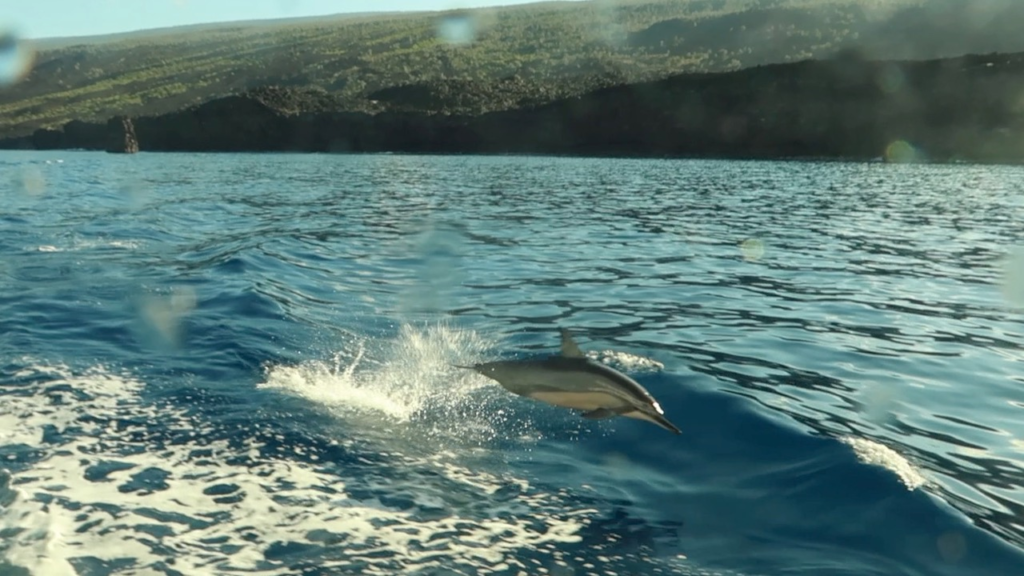By Raquel Gilliland; Sea of Change Intern
It’s time for another great “Creature Feature” where we introduce you to a new animal and talk about their important conservation status. This week’s animal is arguably one of the most charismatic megafauna in the marine world. They are loved by people and the media just as much as they love catching a wave to surf. Sometimes mistaken for a shark, our featured creature is the playful dolphin! “Dolphin” is a widely used term to refer to many species of Odontoceti (toothed whales); and this week we will focus on species within the Family Delphinidae (oceanic dolphins). Some species within this family include: the long and short-beaked common dolphins (Delphinus capensis, Delphinus delphis), the common bottlenose dolphin (Tursiops truncates), the Atlantic spotted dolphin (Stenella frontalis), the spinner dolphin (Stenella longirostris), and the orca (Orcinus orca). We’ll cover fascinating orcas in a future Creature Feature.

Dolphins range in size from the 1.7 m (5.6 ft.) to 9.5 m (31 ft.) long and can weigh between 50 kg (110 lb.) to 5443 kg (12, 000 lb)! They are, generally, very social animals that travel in groups called pods ranging between approximately 20-30 dolphins. There are three main types of pods; nursery pods, juvenile pods, and bachelor pods; sometimes these pods merge into one large pod for special occasions. The nursery pods are made up of mothers and their calves which stay with their mothers for three to six years. Female dolphins will form deep bonds and travel together to help one another raise their calves and teach them how to hunt and survive. When a female is pregnant she will often return to her nursery pod to birth and raise the calves with other mothers and close females like aunts. All calves will eventually leave the nursery pods as juveniles and join a juvenile pod between the ages of 3 and 13 years old. During this time, they spend engage in socializing and matting with dolphins their own age. While in juvenile pods, pairs of males will often form a special bond that lasts a lifetime. This pair works closely together and will later join a bachelor pod and frequently travel between pods.
By traveling in groups dolphins can take care of young calves easier, help injured or sick dolphins, and communicate efficiently. They use a series of squeals and clicks to communicate with each dolphin having an individual high pitched noise that identifies them, similar to a name. They use this sound and echolocation to find one another and send messages to other pods. For example, when one pod finds a group of fish they will often signal to other dolphins in the area to come help heard the fish into a bait ball. The dolphins will then take turns swimming through the bait ball to catch and eat the fish. This way everyone gets more food and stays safer from other predators within the area such as sharks that may also be hunting the fish.
Sharks and orcas are the primary natural predator of dolphins but it is more challenging to attack a dolphin pod than an individual. However, the primary threat to dolphins is humans. Some anthropogenic causes that harm dolphin populations are ocean pollution, bycatch, habitat loss, and even direct dolphin hunting. Some countries still sell dolphin meat as a delicacy while other fishermen in parts of the world are killing dolphins because they are seen as a competitors for the same fish. As dolphins will often swim into bait balls to catch fish for themselves they can be caught in the fishing nets and become victim to bycatch often not surviving the ordeal. The largest threat to dolphins is ocean pollution in the form of plastics and toxins released into the water, reducing their habitats and killing them directly. Most notably, they often fall victim to ocean trash, becoming entangled in ghost nets and ingesting large amounts of plastics.
Here at Sea of Change Foundation we are doing our part to reduce ocean plastics by working with our partners at FORCE BLUE to develop new communication platforms, Savannah State University by funding a student project on microplastics, and with Aggressor Liveaboards™ to help develop their new Green The Fleet™ environmental initiatives to reduce and eliminate single-use plastics from operations.




